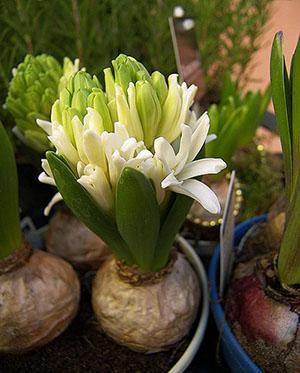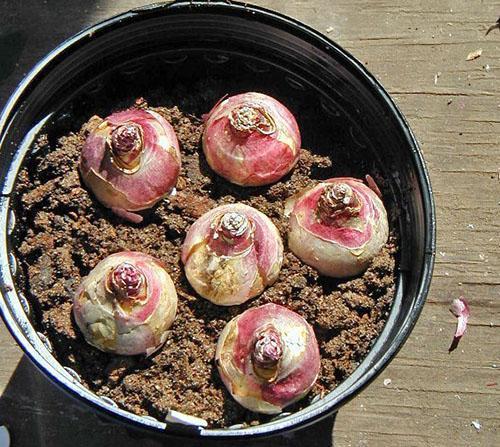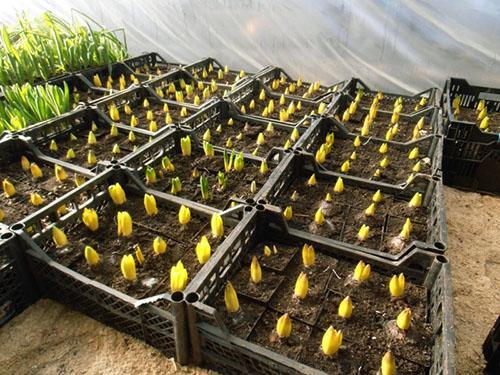Proper planting and care of hyacinths at home
 Hyacinth is a bulbous plant that can be successfully grown both in the garden and at home. Therefore, many amateur flower growers want to grow this flower on their windowsill in order to admire it even in winter, during the cold season. This desire is quite feasible. However, for the successful cultivation of the hyacinth, it is necessary to create the appropriate conditions that resemble garden ones as much as possible, and provide it with proper care.
Hyacinth is a bulbous plant that can be successfully grown both in the garden and at home. Therefore, many amateur flower growers want to grow this flower on their windowsill in order to admire it even in winter, during the cold season. This desire is quite feasible. However, for the successful cultivation of the hyacinth, it is necessary to create the appropriate conditions that resemble garden ones as much as possible, and provide it with proper care.
Preparing for growing hyacinth at home

- Selection of bulbs... First you need to select a suitable material for planting. It is recommended to use bulbs with a minimum diameter of 5 cm. Because it is easier to grow a complete plant from a large bulb. A small bulb may discard leaves but still not produce flowers, and must also be careful to keep it firm and free from rot or damage. And immediately before planting, it is advisable to treat it with a disinfectant solution.
- Pot selection... Then the appropriate pot must be selected. It should be wide and shallow. The pot must have drainage holes.
- Soil preparation... You can buy the soil or prepare it yourself. To do this, mix in equal proportions turf, compost, leafy soil, humus and add a small amount of sand and peat.
There is one caveat when growing hyacinth at home - this flower cannot bloom for several years in a row. Flowering is stimulated by artificial forcing, which weakens the bulbs. Therefore, after 1-2 years, they need to be planted in the garden area so that they go through the recovery period.
Planting and caring for hyacinths indoors
 After preparing the necessary materials, you can start planting the bulbs. Correct planting and caring for hyacinths indoors includes the following steps:
After preparing the necessary materials, you can start planting the bulbs. Correct planting and caring for hyacinths indoors includes the following steps:
- A drainage layer is laid out at the bottom of the pot; expanded clay is well suited for these purposes.
- A small layer of soil is covered.
- Then a thin layer of fine sand is placed.
- Bulbs are placed on top of the sand. You can plant one bulb in a pot, or several, so that a whole bouquet forms during flowering. In the latter case, the bulbs are laid out so that they do not come into contact with each other and with the pot (the optimal distance is 2-3 cm).
- The bulbs are gently pressed into the ground and covered with the remaining earth. From above, the soil can be sprinkled with a thin layer of sand to protect the planting material from decay.
The bulbs are not completely submerged in the soil; their tops must always remain in the air.
 A dormant period is now created for the plants so that the bulbs take root well. The pot is placed for 1.5–2.5 months in a dark and cool place, such as a basement. The air temperature in this room should be between +5 and +10 degrees. If there is no basement or cellar, flowers can be placed in the refrigerator. However, it is imperative to ensure that the temperature in it is at least 5 degrees Celsius. During this period, it is necessary to monitor the condition of the soil in order to prevent it from drying out.
A dormant period is now created for the plants so that the bulbs take root well. The pot is placed for 1.5–2.5 months in a dark and cool place, such as a basement. The air temperature in this room should be between +5 and +10 degrees. If there is no basement or cellar, flowers can be placed in the refrigerator. However, it is imperative to ensure that the temperature in it is at least 5 degrees Celsius. During this period, it is necessary to monitor the condition of the soil in order to prevent it from drying out.
A dormant period is necessary for the successful cultivation of hyacinths indoors. If the plant is brought out earlier “into the light”, it may still be weak, develop poorly and, as a result, not bloom. Overexposure in the dark is also not recommended. The plant will throw out the leaves, all the power will go into them, and as a result, the formation of buds will be delayed.
After the rooting of the bulbs, an artificial spring is arranged for the hyacinths, for this the flowers are moved into the house. Here hyacinths should be in a bright room, with the recommended air temperature of + 10-15 degrees.
As soon as the plant begins to bloom, it is transferred to the desired room, and put away from the radiators. In order for the hyacinth to delight the owners for a long time with lush luxurious flowers, the air temperature should be no higher than +20 degrees. In addition, it is necessary to exclude the existence of drafts and provide the plant with good lighting.
How to care for hyacinth at home?
 To grow lush, beautiful flowers, you need to take care of them. How to care for a hyacinth at home so that it blooms as soon as possible and delights the owners for a long time with beautiful flowers?
To grow lush, beautiful flowers, you need to take care of them. How to care for a hyacinth at home so that it blooms as soon as possible and delights the owners for a long time with beautiful flowers?
Hyacinth care is relatively simple, and includes three essential components:
- watering;
- good lighting;
- fertilizer.
Watering. The basis of hyacinth care in indoor conditions is a competent watering... The soil must be moist, so it is necessary to carefully monitor so that it does not dry out, and water the plant in a timely manner. This requirement is important during growth, flowering and overwintering. However, stagnation of water for this plant is also destructive and can provoke a fungal infection. Therefore, you need to make sure that excess water goes into the sump, and be sure to drain it from there.
During watering, you only need to moisten the soil, and make sure that water does not get on the buds, onion and in the leaf axils. For this, it is recommended to pour water into the edge of the pot, or the pan.
 Good lighting. From time to time it is necessary to turn the flower to the lighting in different directions. This helps the plant grow evenly. In the evening and on cloudy days, you can additionally illuminate the plant using fluorescent lamps. With a lack of lighting, the plant can wither, discard leaves and young buds.
Good lighting. From time to time it is necessary to turn the flower to the lighting in different directions. This helps the plant grow evenly. In the evening and on cloudy days, you can additionally illuminate the plant using fluorescent lamps. With a lack of lighting, the plant can wither, discard leaves and young buds.
Fertilizer. It is recommended to feed hyacinths 2 times a month. For this, special fertilizers are used, which are diluted according to the instructions.
Forcing hyacinths at home
 A nice feature of hyacinth is the ability to combine its flowering with a certain period or holiday. For this, hyacinths are distilled at home. It is of three types:
A nice feature of hyacinth is the ability to combine its flowering with a certain period or holiday. For this, hyacinths are distilled at home. It is of three types:
- early - the bulbs are planted in October, and the hyacinth blooms by the New Year;
- medium - planting is carried out in November, and flowering falls in late January - early February;
- late - the bulbs are planted in December - January and admire the flowers in March - April.
The period from planting to flowering averages 2.5–3 months.
For the safe forcing of hyacinths at home, the bulbs must go through several stages of preparation with a gradual decrease in air temperature. After digging, they should be stored for 2 weeks in a warm and humid place with an air temperature of + 28-30 degrees. Then for 2 weeks they are placed in a cool room with a temperature of + 22-25 degrees. Further, even colder conditions are created for 2 weeks - + 15-17 degrees. And after that, the bulbs are ready for planting in a pot.
What to do after hyacinth blooms?
 Like all flowering plants, hyacinth fades over time. What to do with hyacinth after flowering at home? To keep him alive, it is necessary to cut the flower stalks and not stop watering and fertilizing the plant until the leaves completely wither. At this time, the mother bulb is restored and can form daughter bulbs.
Like all flowering plants, hyacinth fades over time. What to do with hyacinth after flowering at home? To keep him alive, it is necessary to cut the flower stalks and not stop watering and fertilizing the plant until the leaves completely wither. At this time, the mother bulb is restored and can form daughter bulbs.
Then you need to remove the hyacinth from the ground, peel off wilted leaves and put the bulb to dry for 2-3 days. If, after digging the bulbs, the babies are already well developed, you can separate them. If they do not detach well, it is better not to touch them until next year. Since it is advisable not to use faded bulbs for re-distillation, they are transplanted to the garden plot. Planting is carried out in the fall, and next year they already delight the owners with flowers in the flowerbed.
To obtain bulbs that can be used for indoor cultivation, the plant is not allowed to bloom normally. The buds are cut off so that the bulb can recover. In the fall, it is taken out of the ground, dried, and again the forcing procedure is carried out.
Reproduction of hyacinths at home
 Hyacinth is propagated by babies (daughter bulbs), which are carefully detached from the adult bulb. Natural division occurs slowly; in one year, the mother bulb can form a maximum of 4 babies. Therefore, in floriculture, an artificial method of reproduction of hyacinths is used at home. To quickly get a large number of children, they practice special techniques - cutting and notching the bottom.
Hyacinth is propagated by babies (daughter bulbs), which are carefully detached from the adult bulb. Natural division occurs slowly; in one year, the mother bulb can form a maximum of 4 babies. Therefore, in floriculture, an artificial method of reproduction of hyacinths is used at home. To quickly get a large number of children, they practice special techniques - cutting and notching the bottom.
Before starting artificial propagation, the bulbs are treated with a 1% solution of potassium permanganate and dried at an air temperature of + 20-23 degrees for 2-3 days.
Cutting the bottom... This technique is carried out after a period of rest. With a teaspoon in the bulbs, carefully cut out the bottom, then store them in boxes with a cut upwards at an air temperature of at least +21 degrees. After 2–3 months, small babies in the amount of 20–40 pieces begin to form on the sections.
After the appearance of the children, the bulb is planted in a cool greenhouse. Young bulbs begin to grow and discard the first leaves. After the growing season, they are taken out of the ground, separated and planted for growing. After 3-4 years, ripe bulbs throw out their first flower stalks.
Cutting the bottom. This method is similar to the previous one, with the difference that the base is not cut out, but 2–4 cuts are made in it, 0.5–0.6 cm deep. Processing and storage conditions are the same as in the first method. With this method, the number of children decreases (8–15 pcs.), But they will be larger and stronger. The growing period in this case is reduced to 2-3 years.
The process of growing hyacinths at home is quite simple, but very fruitful. To successfully complete it, you need to have a lot of desire and a little patience. And, of course, follow all the rules and recommendations that relate to planting and caring for hyacinths indoors.
THANK YOU !!!
I bought a hyacinth blooming in November, the leaves are now withering, how to take care of the bulb in the future to plant it in the garden
Reduce watering to a minimum and cut the leaves. I would leave the bulb in the pot, and in the spring, when it gets warmer, I would plant it in the garden. But most likely, this year it will not bloom, because it did not rest in winter.
I have now blossomed. Can you leave it in a pot like other indoor plants?
Hello! I have bloomed hyacinth now, on October 3, in the front garden. I bought it blooming in a pot on March 8. What should I do? dig or leave in the ground outside?
Most gardeners advise cutting the stem off so that it does not weaken the plant and it can winter well. You can do that. If it's a pity, you can dig it out - let it bloom in the house, but then be sure to give the bulb a rest, gradually reducing watering. In the spring, plant her back in the flower bed.
Help me please. The hyacinth began to wake up at the end of October. I dropped him off.Now it's January and he gave me a miracle. It bloomed right in the bulb, not having time to expel the arrow ((what should I do ?? (((
Put the pot in the sun, but not to be too hot, and let it bloom for yourself. After the end of flowering, cut the peduncle, and in the spring it will be possible to plant the bulb in the flower bed.
Thank you !!!
In the spring they planted it on a flower bed, but in the fall it is necessary to dig it up again and transplant it into a pot? Or do they hibernate in the garden?
If you plan to put the bulbs for forcing, then you need to dig them up. I just planted my flower donated by March 8 after flowering on a flower bed. I have already survived two winters, and every spring it bloomed (the main thing is not to forget where it was planted, otherwise I almost pulled it out with a hoe). So they winter well, however, in winter we have a maximum - 20 ° frost.